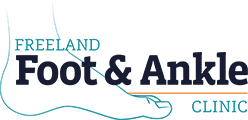Nobody gets through life without their fair share of bumps in life. The key is knowing which ones you should ride out and which ones you should work on overcoming. When it comes to literal bumps in life, such as those caused by bunions and hammertoes, many people choose the former over the latter. They either feel it’s too late to do anything once a toe deformity starts to develop, or they have already lived with one for so long that taking action now feels futile and silly.
The truth, however, is there is often much more someone can do to help manage their bunion or hammertoe discomfort than they might expect. And this is not just referring to surgery, either! The primary goal of most bunion and hammertoe treatments is to relieve pain and discomfort while preventing the deformity from becoming worse. Surgery is usually only considered as an option if these attempts fail. If you have just been letting those painful toe bumps slide, it’s time to fight back! The methods below range from simple changes you can make at home to treatments you can receive from us. None of them will make a bunion or hammertoe disappear, but they can still have a big impact on your day-to-day life.
Start with Your Shoes
It probably goes without saying that certain shoes can make your bunion or hammertoe feel a lot worse. And while the wrong shoes might not technically
Lower heals and flats are always preferred. Shoes should also have a wide toe box, and not one that narrows or results in a point. The material of the shoe should not be stiff, but
Stretch and Strengthen
Exercising your toes is a great way to maintain flexibility and mobility in your toe joints. It’s also a great way to strengthen the muscles in your toes, helping to keep toes stabilized and slowing the progression of a bunion or hammertoe. Try incorporating some of these easy exercises as part of a routine. Starting and ending the day with them works well, but they’re also short and simple enough to perform whenever you have a free moment:
- Towel Curls: Sit in a chair and place a small towel (like a handtowel) on the floor in front of your feet. Using one foot, curl your toes against the towel and pull it toward you, as if trying to scrunch the towel up beneath your foot. Repeat this 5 times per foot.
- Marble Pickup: This is another exercise that involves gripping with the toes. Sit the same way you would for Towel Curls, but this time place 20 marbles on the floor in front of you (or however many you have). Using one foot, pick up the marbles one by one and deposit them in a bowl. Repeat with the other foot. (If you have fewer marbles, simply perform 20 repetitions for each foot.)
- Big Toe Stretch: More specifically for bunions, use your fingers to gently shift your big toe toward its proper place and alignment (but stop if this is causing you pain!). Hold this position for 10 seconds and repeat several times.
- Flexion and Contraction: Press your toes against a hard surface (like a wall or the side of a bottom step) to stretch them while flexing. Hold this position for about 10 seconds, repeating several times. Flex in the opposite direction against the surface and hold for the same amount of time, again for several repetitions.
We would be happy to talk with you about what exercises might be best for your particular situation, or which ones may be preferable if arthritis and other pains might be interfering with a routine.

Helping You Over the Hump
In addition to providing custom orthotics (mentioned above) and guidance in stretching, Freeland Foot & Ankle Clinic can be a valuable resource for bunion and hammertoe management in other ways. The proper use of a night splint can help hold a toe in a more natural and comfortable position. We might also recommend specialized shoes or certain medications if over-the-counter pain relievers are not effective. However, if such measures don’t work, surgery may be discussed as an option to correct the deformity and restore comfort. We will make sure to fully go over all the pros and cons of such a procedure with you before determining whether to move forward. If bunions or hammertoes have been a companion on your road of life, don’t just let them get in the way unabated! Call our Freeland office at (989) 695-6788 to schedule an appointment and take that first step!

